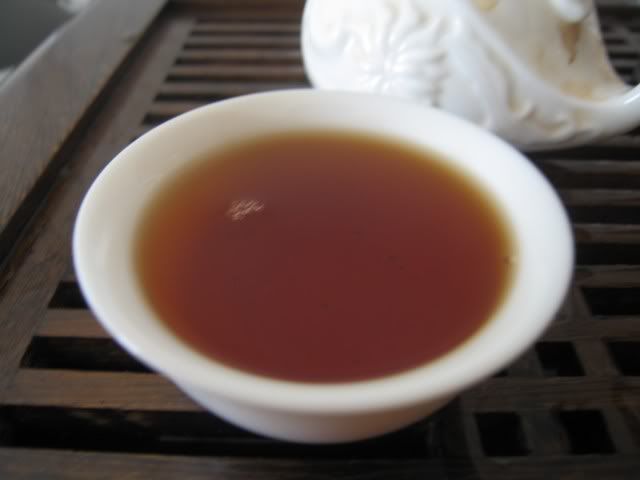Today I ran a test that somebody on Sanzui suggested. It’s for the Yiwu cake that I have, because there was some reddish colour on the leaves I tried last time. There’s speculation that it could have undergone “pre-oxidation” much like an oolong, and thus producing a tea that is less desirable in the long run.
The method is brewing using 1:16 ratio of tea:water, then by pouring gently on the side of the gaiwan, leave the first brew for 30s, second for 1 minute, then 30s again. The goal, supposedly, is to see if there are funny business going on with bitterness, which the guy referred to as “bitterness peeling off”. I’m not sure what exactly that means.
However, I can report that I find no significant difference between this brew and the last one. In fact, this one tasted a bit better. If you look at the leaves and the liquor, the colour is also lighter. I wonder if the leaves I picked last time somehow tended to be redder, mostly because it’s stuff on the surface, meaning larger leaves, meaning easier to get bruised during the processing? I’m not sure. Take a look yourself and compare it with the pics down the page in my old entry.



I can say that the cha qi, even with so little leaves, was evident, with my heart pumping quite fast and also feeling a bit of a sweat even with so little leaves. I think after this tasting I feel a bit better about buying the whole tong :). Even if it doesn’t turn out so good in 5-10 years…. it tastes quite good now!
But as you can probably guess, so little leaves wasn’t going to satisfy me, so I brewed up something else. I decided to give the brick I recently bought a try. This brick is also labeled as Keyixing, but it’s a different production and I think a later one. However, there is talk that this is actually a re-pressed brick using loose, aged maocha. I can believe that.
Anyway, here are the pics
Front
Back
Edge
Quite shiny. It must’ve been dry stored, and stored decently well (unlike the other bricks I have, which are quite poorly stored). I am thinking this is, at the very least, a good lesson in storage. If you put them side by side… it’s obvious right away which one is dry stored.
This is what it looks like when I broke a corner…. the inside is more or less the same as outside, which is good. Sometimes bricks are filled with shavings and fannings, and ditto for cakes. This is why it’s best to have someone open it up for you to taste

So I brewed it in my pot. The taste….. it tasted quite bitter initially. Part of the problem is that the Yiwu filled my mouth with sweetness, so I think in comparison it tastes quite bitter. There’s that sharp taste of green puerh that still hasn’t gone away. Judging from the colour of the liquor, I’d say it’s about 10-15 years

It then mellows out a bit. There’s a good bit of camphor taste, and then it turns into a chocolate like aroma, and descends into the sweet tasting water that older puerh tends to be. There seems to be a bit of wild tea in there, because once again, I am tasting that “wild” taste. Of course, I don’t know if that’s what it actually is, but let’s just call it that for now.
Here are the brewed leaves

Not a great tea, I think. Water is a bit thin, and the complexity lacking, but it makes up for it with its age, and most importantly, the relatively cheap price 🙂

 RSS - Posts
RSS - Posts
0 responses so far ↓
There are no comments yet...Kick things off by filling out the form below.